Planning, Delivering & Assessing Learners in Own Specialist Area
VerifiedAdded on 2023/06/14
|17
|5356
|169
Report
AI Summary
This report provides a comprehensive analysis of planning, delivering, and assessing learners within a specialist area. It covers various aspects including the teacher's roles and responsibilities in education and training, relevant legislation and codes of practice, and the relationships between teaching roles and other professional roles. The report also examines the use of initial and diagnostic assessments in setting individual learning goals, the importance of meeting individual needs, and adapting teaching plans to suit diverse learners. Furthermore, it discusses promoting appropriate behavior, equality, and diversity in the learning environment. The document also delves into assessment types, methods, feedback, and communication, as well as the application of minimum core elements. Finally, it evaluates the effectiveness of teaching approaches, communication methods, resources, and assessment techniques, and reviews the effectiveness of inclusive teaching practices, identifying areas for improvement. This resource is ideal for students seeking a deeper understanding of effective teaching and assessment strategies.
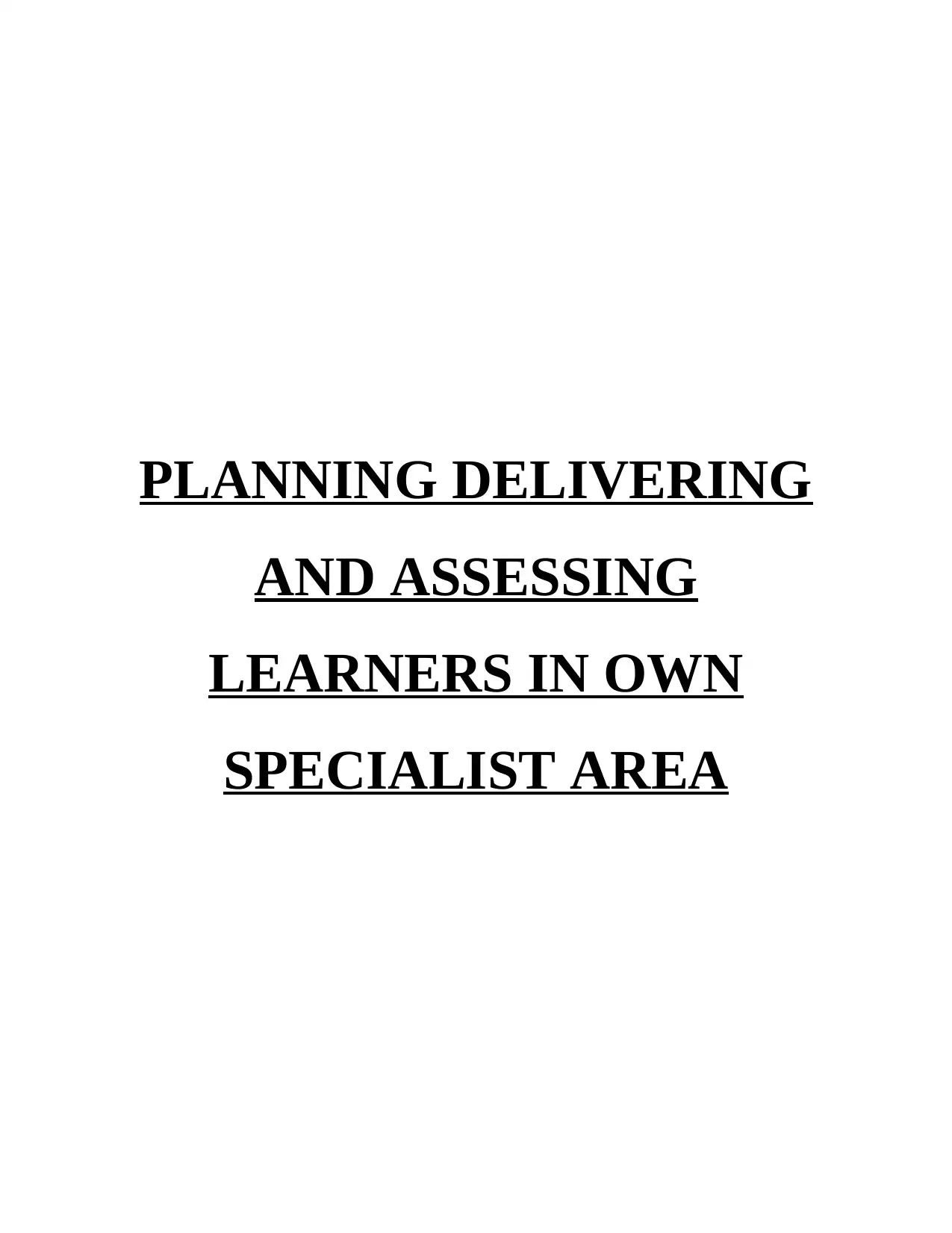
PLANNING DELIVERING
AND ASSESSING
LEARNERS IN OWN
SPECIALIST AREA
AND ASSESSING
LEARNERS IN OWN
SPECIALIST AREA
Paraphrase This Document
Need a fresh take? Get an instant paraphrase of this document with our AI Paraphraser
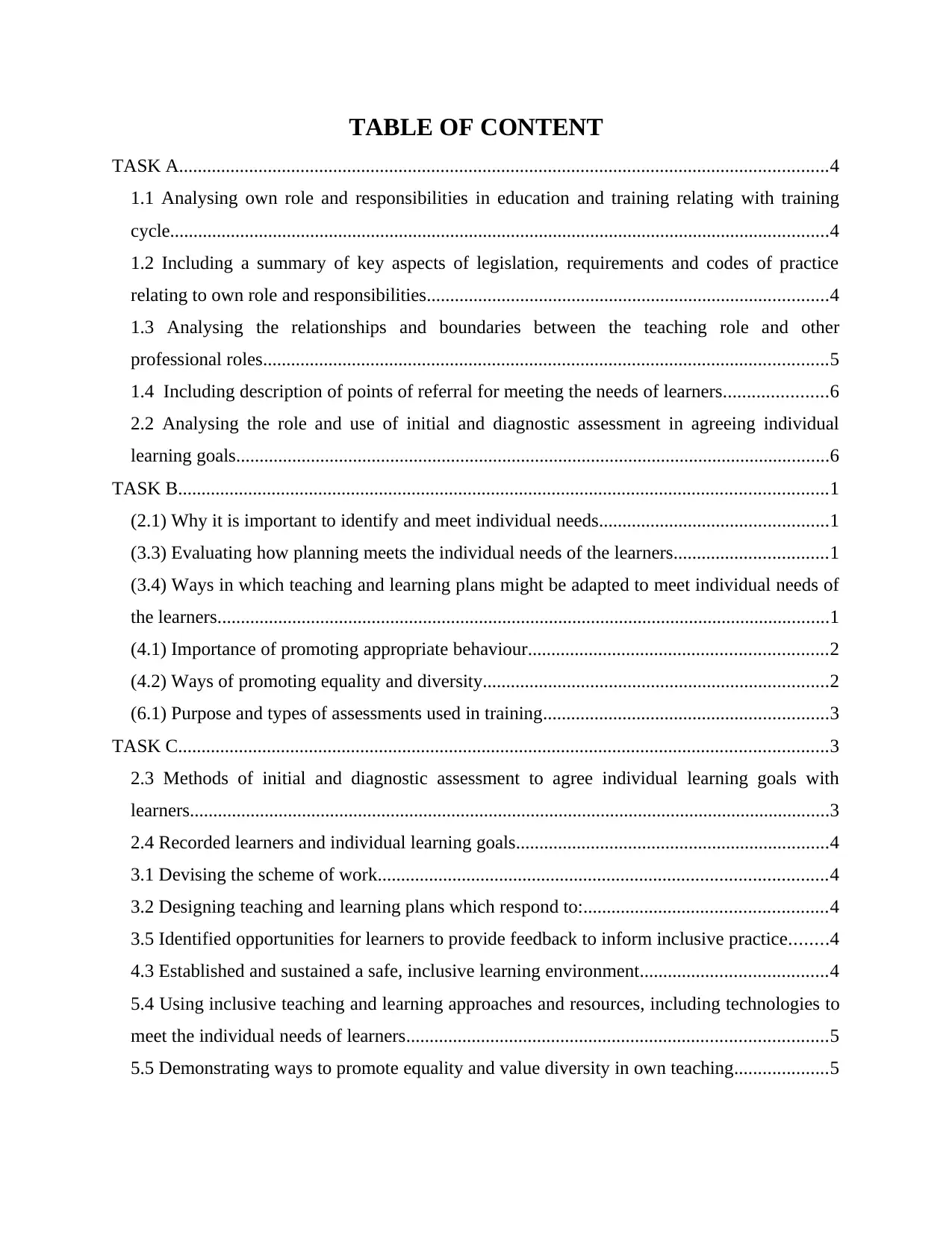
TABLE OF CONTENT
TASK A...........................................................................................................................................4
1.1 Analysing own role and responsibilities in education and training relating with training
cycle.............................................................................................................................................4
1.2 Including a summary of key aspects of legislation, requirements and codes of practice
relating to own role and responsibilities......................................................................................4
1.3 Analysing the relationships and boundaries between the teaching role and other
professional roles.........................................................................................................................5
1.4 Including description of points of referral for meeting the needs of learners......................6
2.2 Analysing the role and use of initial and diagnostic assessment in agreeing individual
learning goals...............................................................................................................................6
TASK B...........................................................................................................................................1
(2.1) Why it is important to identify and meet individual needs.................................................1
(3.3) Evaluating how planning meets the individual needs of the learners.................................1
(3.4) Ways in which teaching and learning plans might be adapted to meet individual needs of
the learners...................................................................................................................................1
(4.1) Importance of promoting appropriate behaviour................................................................2
(4.2) Ways of promoting equality and diversity..........................................................................2
(6.1) Purpose and types of assessments used in training.............................................................3
TASK C...........................................................................................................................................3
2.3 Methods of initial and diagnostic assessment to agree individual learning goals with
learners.........................................................................................................................................3
2.4 Recorded learners and individual learning goals...................................................................4
3.1 Devising the scheme of work................................................................................................4
3.2 Designing teaching and learning plans which respond to:....................................................4
3.5 Identified opportunities for learners to provide feedback to inform inclusive practice........4
4.3 Established and sustained a safe, inclusive learning environment........................................4
5.4 Using inclusive teaching and learning approaches and resources, including technologies to
meet the individual needs of learners..........................................................................................5
5.5 Demonstrating ways to promote equality and value diversity in own teaching....................5
TASK A...........................................................................................................................................4
1.1 Analysing own role and responsibilities in education and training relating with training
cycle.............................................................................................................................................4
1.2 Including a summary of key aspects of legislation, requirements and codes of practice
relating to own role and responsibilities......................................................................................4
1.3 Analysing the relationships and boundaries between the teaching role and other
professional roles.........................................................................................................................5
1.4 Including description of points of referral for meeting the needs of learners......................6
2.2 Analysing the role and use of initial and diagnostic assessment in agreeing individual
learning goals...............................................................................................................................6
TASK B...........................................................................................................................................1
(2.1) Why it is important to identify and meet individual needs.................................................1
(3.3) Evaluating how planning meets the individual needs of the learners.................................1
(3.4) Ways in which teaching and learning plans might be adapted to meet individual needs of
the learners...................................................................................................................................1
(4.1) Importance of promoting appropriate behaviour................................................................2
(4.2) Ways of promoting equality and diversity..........................................................................2
(6.1) Purpose and types of assessments used in training.............................................................3
TASK C...........................................................................................................................................3
2.3 Methods of initial and diagnostic assessment to agree individual learning goals with
learners.........................................................................................................................................3
2.4 Recorded learners and individual learning goals...................................................................4
3.1 Devising the scheme of work................................................................................................4
3.2 Designing teaching and learning plans which respond to:....................................................4
3.5 Identified opportunities for learners to provide feedback to inform inclusive practice........4
4.3 Established and sustained a safe, inclusive learning environment........................................4
5.4 Using inclusive teaching and learning approaches and resources, including technologies to
meet the individual needs of learners..........................................................................................5
5.5 Demonstrating ways to promote equality and value diversity in own teaching....................5
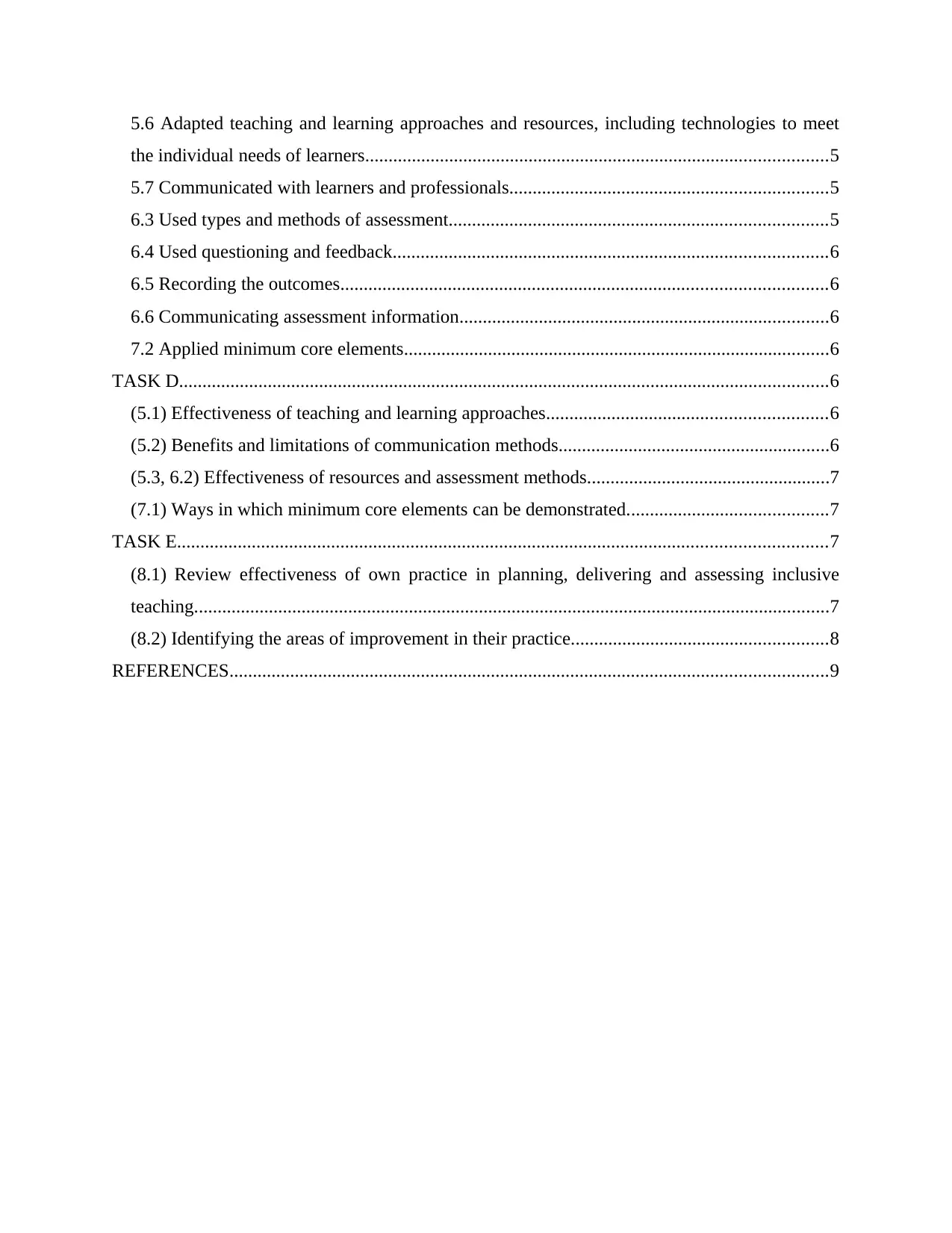
5.6 Adapted teaching and learning approaches and resources, including technologies to meet
the individual needs of learners...................................................................................................5
5.7 Communicated with learners and professionals....................................................................5
6.3 Used types and methods of assessment.................................................................................5
6.4 Used questioning and feedback.............................................................................................6
6.5 Recording the outcomes........................................................................................................6
6.6 Communicating assessment information...............................................................................6
7.2 Applied minimum core elements...........................................................................................6
TASK D...........................................................................................................................................6
(5.1) Effectiveness of teaching and learning approaches............................................................6
(5.2) Benefits and limitations of communication methods..........................................................6
(5.3, 6.2) Effectiveness of resources and assessment methods....................................................7
(7.1) Ways in which minimum core elements can be demonstrated...........................................7
TASK E...........................................................................................................................................7
(8.1) Review effectiveness of own practice in planning, delivering and assessing inclusive
teaching........................................................................................................................................7
(8.2) Identifying the areas of improvement in their practice.......................................................8
REFERENCES................................................................................................................................9
the individual needs of learners...................................................................................................5
5.7 Communicated with learners and professionals....................................................................5
6.3 Used types and methods of assessment.................................................................................5
6.4 Used questioning and feedback.............................................................................................6
6.5 Recording the outcomes........................................................................................................6
6.6 Communicating assessment information...............................................................................6
7.2 Applied minimum core elements...........................................................................................6
TASK D...........................................................................................................................................6
(5.1) Effectiveness of teaching and learning approaches............................................................6
(5.2) Benefits and limitations of communication methods..........................................................6
(5.3, 6.2) Effectiveness of resources and assessment methods....................................................7
(7.1) Ways in which minimum core elements can be demonstrated...........................................7
TASK E...........................................................................................................................................7
(8.1) Review effectiveness of own practice in planning, delivering and assessing inclusive
teaching........................................................................................................................................7
(8.2) Identifying the areas of improvement in their practice.......................................................8
REFERENCES................................................................................................................................9
⊘ This is a preview!⊘
Do you want full access?
Subscribe today to unlock all pages.

Trusted by 1+ million students worldwide
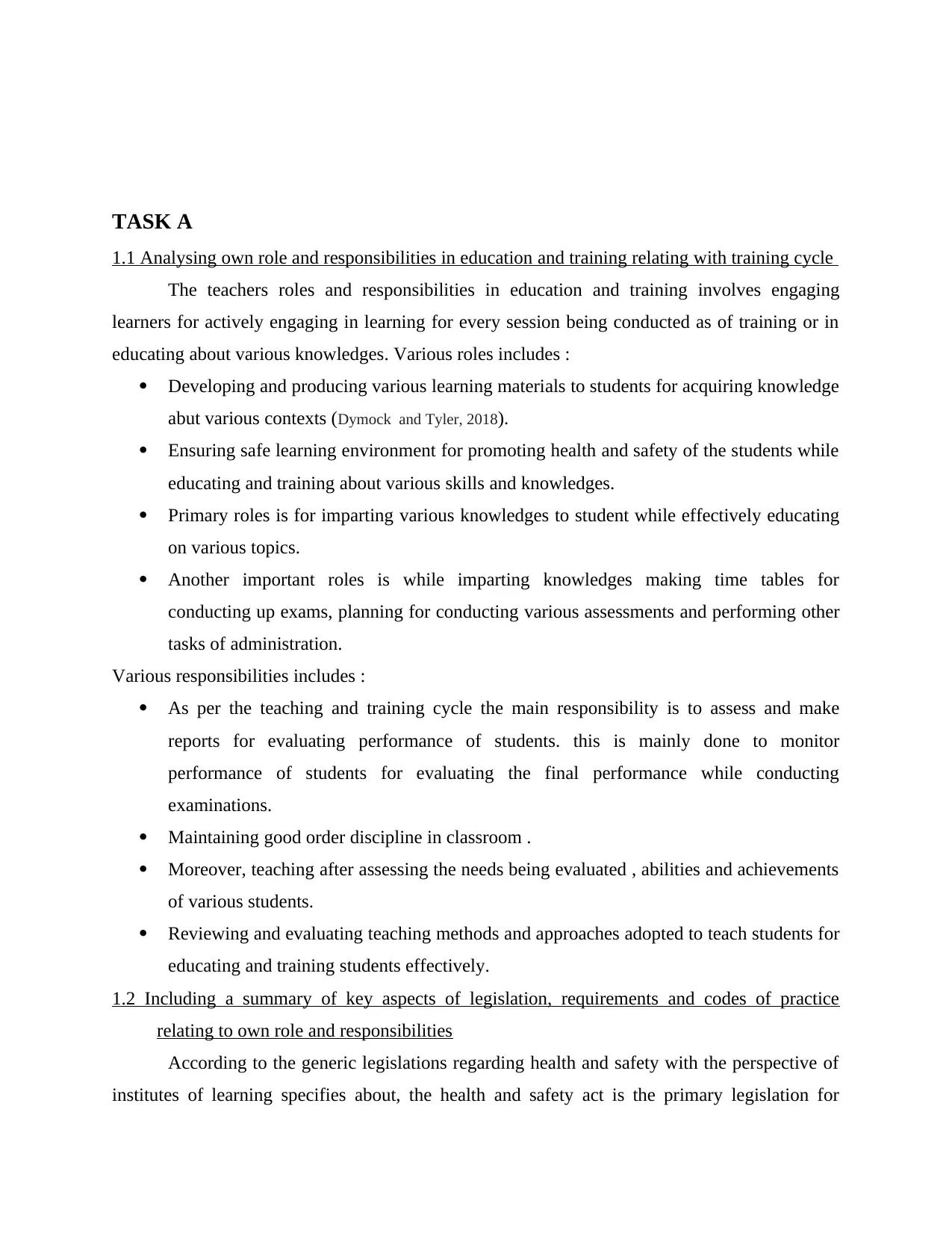
TASK A
1.1 Analysing own role and responsibilities in education and training relating with training cycle
The teachers roles and responsibilities in education and training involves engaging
learners for actively engaging in learning for every session being conducted as of training or in
educating about various knowledges. Various roles includes :
Developing and producing various learning materials to students for acquiring knowledge
abut various contexts (Dymock and Tyler, 2018).
Ensuring safe learning environment for promoting health and safety of the students while
educating and training about various skills and knowledges.
Primary roles is for imparting various knowledges to student while effectively educating
on various topics.
Another important roles is while imparting knowledges making time tables for
conducting up exams, planning for conducting various assessments and performing other
tasks of administration.
Various responsibilities includes :
As per the teaching and training cycle the main responsibility is to assess and make
reports for evaluating performance of students. this is mainly done to monitor
performance of students for evaluating the final performance while conducting
examinations.
Maintaining good order discipline in classroom .
Moreover, teaching after assessing the needs being evaluated , abilities and achievements
of various students.
Reviewing and evaluating teaching methods and approaches adopted to teach students for
educating and training students effectively.
1.2 Including a summary of key aspects of legislation, requirements and codes of practice
relating to own role and responsibilities
According to the generic legislations regarding health and safety with the perspective of
institutes of learning specifies about, the health and safety act is the primary legislation for
1.1 Analysing own role and responsibilities in education and training relating with training cycle
The teachers roles and responsibilities in education and training involves engaging
learners for actively engaging in learning for every session being conducted as of training or in
educating about various knowledges. Various roles includes :
Developing and producing various learning materials to students for acquiring knowledge
abut various contexts (Dymock and Tyler, 2018).
Ensuring safe learning environment for promoting health and safety of the students while
educating and training about various skills and knowledges.
Primary roles is for imparting various knowledges to student while effectively educating
on various topics.
Another important roles is while imparting knowledges making time tables for
conducting up exams, planning for conducting various assessments and performing other
tasks of administration.
Various responsibilities includes :
As per the teaching and training cycle the main responsibility is to assess and make
reports for evaluating performance of students. this is mainly done to monitor
performance of students for evaluating the final performance while conducting
examinations.
Maintaining good order discipline in classroom .
Moreover, teaching after assessing the needs being evaluated , abilities and achievements
of various students.
Reviewing and evaluating teaching methods and approaches adopted to teach students for
educating and training students effectively.
1.2 Including a summary of key aspects of legislation, requirements and codes of practice
relating to own role and responsibilities
According to the generic legislations regarding health and safety with the perspective of
institutes of learning specifies about, the health and safety act is the primary legislation for
Paraphrase This Document
Need a fresh take? Get an instant paraphrase of this document with our AI Paraphraser
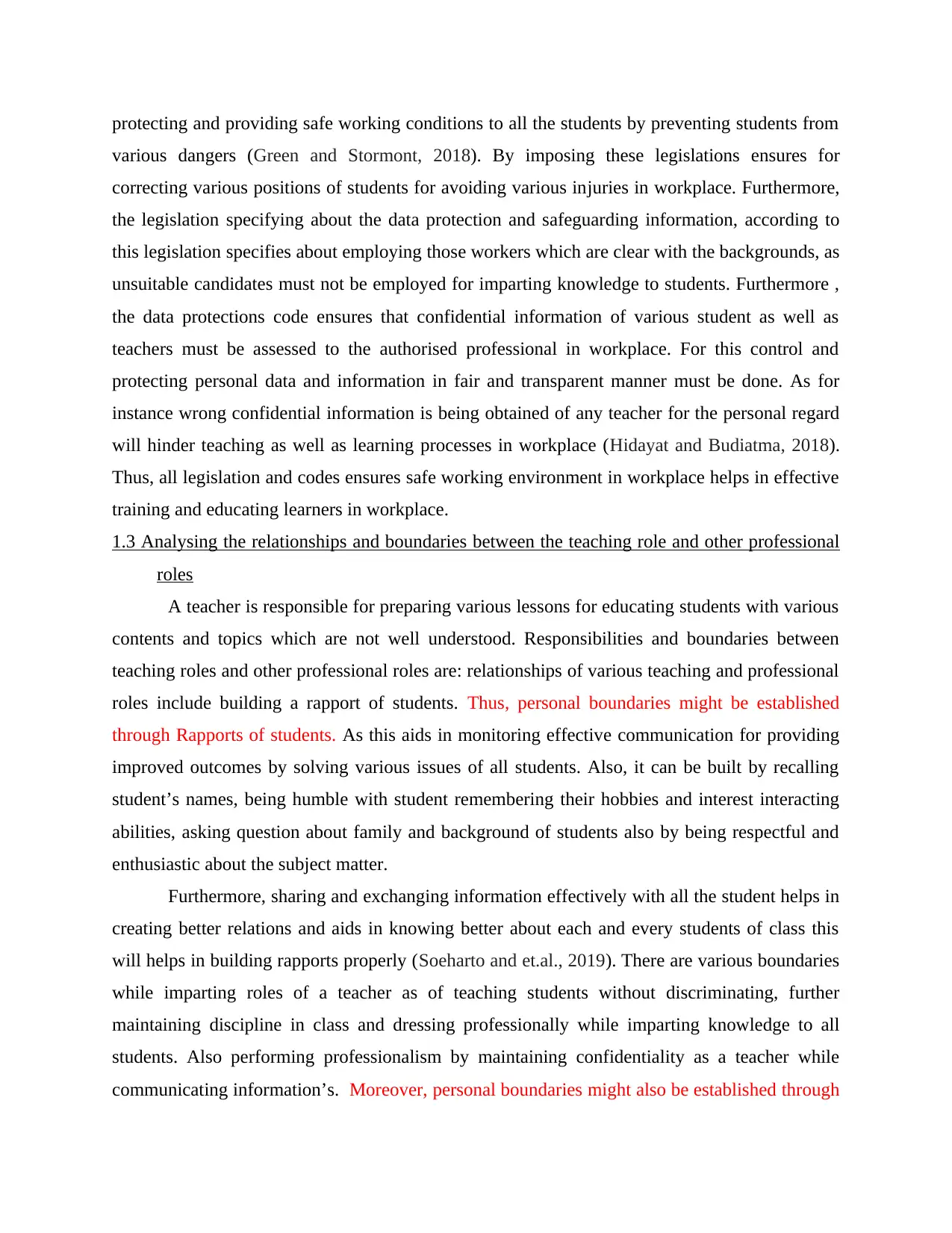
protecting and providing safe working conditions to all the students by preventing students from
various dangers (Green and Stormont, 2018). By imposing these legislations ensures for
correcting various positions of students for avoiding various injuries in workplace. Furthermore,
the legislation specifying about the data protection and safeguarding information, according to
this legislation specifies about employing those workers which are clear with the backgrounds, as
unsuitable candidates must not be employed for imparting knowledge to students. Furthermore ,
the data protections code ensures that confidential information of various student as well as
teachers must be assessed to the authorised professional in workplace. For this control and
protecting personal data and information in fair and transparent manner must be done. As for
instance wrong confidential information is being obtained of any teacher for the personal regard
will hinder teaching as well as learning processes in workplace (Hidayat and Budiatma, 2018).
Thus, all legislation and codes ensures safe working environment in workplace helps in effective
training and educating learners in workplace.
1.3 Analysing the relationships and boundaries between the teaching role and other professional
roles
A teacher is responsible for preparing various lessons for educating students with various
contents and topics which are not well understood. Responsibilities and boundaries between
teaching roles and other professional roles are: relationships of various teaching and professional
roles include building a rapport of students. Thus, personal boundaries might be established
through Rapports of students. As this aids in monitoring effective communication for providing
improved outcomes by solving various issues of all students. Also, it can be built by recalling
student’s names, being humble with student remembering their hobbies and interest interacting
abilities, asking question about family and background of students also by being respectful and
enthusiastic about the subject matter.
Furthermore, sharing and exchanging information effectively with all the student helps in
creating better relations and aids in knowing better about each and every students of class this
will helps in building rapports properly (Soeharto and et.al., 2019). There are various boundaries
while imparting roles of a teacher as of teaching students without discriminating, further
maintaining discipline in class and dressing professionally while imparting knowledge to all
students. Also performing professionalism by maintaining confidentiality as a teacher while
communicating information’s. Moreover, personal boundaries might also be established through
various dangers (Green and Stormont, 2018). By imposing these legislations ensures for
correcting various positions of students for avoiding various injuries in workplace. Furthermore,
the legislation specifying about the data protection and safeguarding information, according to
this legislation specifies about employing those workers which are clear with the backgrounds, as
unsuitable candidates must not be employed for imparting knowledge to students. Furthermore ,
the data protections code ensures that confidential information of various student as well as
teachers must be assessed to the authorised professional in workplace. For this control and
protecting personal data and information in fair and transparent manner must be done. As for
instance wrong confidential information is being obtained of any teacher for the personal regard
will hinder teaching as well as learning processes in workplace (Hidayat and Budiatma, 2018).
Thus, all legislation and codes ensures safe working environment in workplace helps in effective
training and educating learners in workplace.
1.3 Analysing the relationships and boundaries between the teaching role and other professional
roles
A teacher is responsible for preparing various lessons for educating students with various
contents and topics which are not well understood. Responsibilities and boundaries between
teaching roles and other professional roles are: relationships of various teaching and professional
roles include building a rapport of students. Thus, personal boundaries might be established
through Rapports of students. As this aids in monitoring effective communication for providing
improved outcomes by solving various issues of all students. Also, it can be built by recalling
student’s names, being humble with student remembering their hobbies and interest interacting
abilities, asking question about family and background of students also by being respectful and
enthusiastic about the subject matter.
Furthermore, sharing and exchanging information effectively with all the student helps in
creating better relations and aids in knowing better about each and every students of class this
will helps in building rapports properly (Soeharto and et.al., 2019). There are various boundaries
while imparting roles of a teacher as of teaching students without discriminating, further
maintaining discipline in class and dressing professionally while imparting knowledge to all
students. Also performing professionalism by maintaining confidentiality as a teacher while
communicating information’s. Moreover, personal boundaries might also be established through
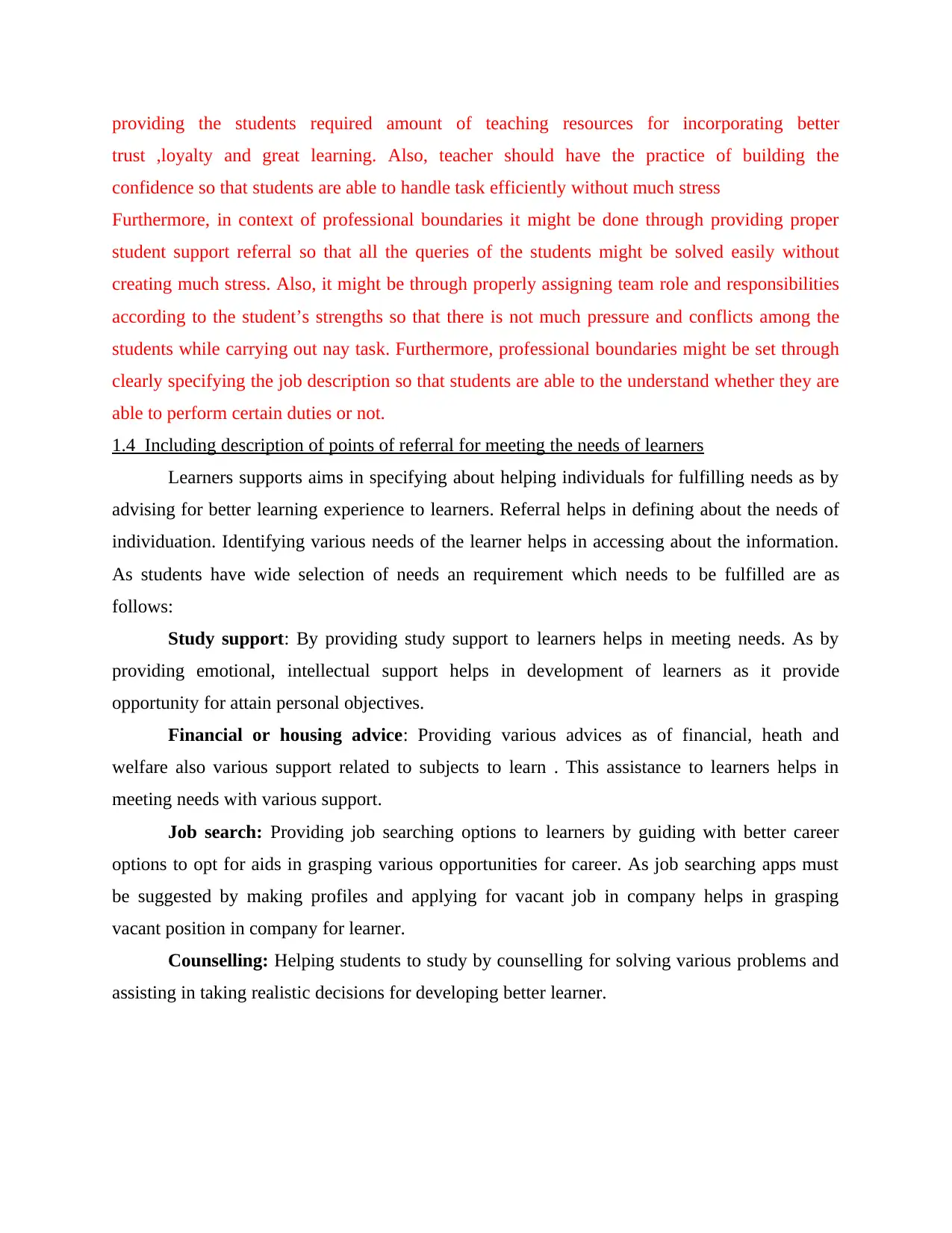
providing the students required amount of teaching resources for incorporating better
trust ,loyalty and great learning. Also, teacher should have the practice of building the
confidence so that students are able to handle task efficiently without much stress
Furthermore, in context of professional boundaries it might be done through providing proper
student support referral so that all the queries of the students might be solved easily without
creating much stress. Also, it might be through properly assigning team role and responsibilities
according to the student’s strengths so that there is not much pressure and conflicts among the
students while carrying out nay task. Furthermore, professional boundaries might be set through
clearly specifying the job description so that students are able to the understand whether they are
able to perform certain duties or not.
1.4 Including description of points of referral for meeting the needs of learners
Learners supports aims in specifying about helping individuals for fulfilling needs as by
advising for better learning experience to learners. Referral helps in defining about the needs of
individuation. Identifying various needs of the learner helps in accessing about the information.
As students have wide selection of needs an requirement which needs to be fulfilled are as
follows:
Study support: By providing study support to learners helps in meeting needs. As by
providing emotional, intellectual support helps in development of learners as it provide
opportunity for attain personal objectives.
Financial or housing advice: Providing various advices as of financial, heath and
welfare also various support related to subjects to learn . This assistance to learners helps in
meeting needs with various support.
Job search: Providing job searching options to learners by guiding with better career
options to opt for aids in grasping various opportunities for career. As job searching apps must
be suggested by making profiles and applying for vacant job in company helps in grasping
vacant position in company for learner.
Counselling: Helping students to study by counselling for solving various problems and
assisting in taking realistic decisions for developing better learner.
trust ,loyalty and great learning. Also, teacher should have the practice of building the
confidence so that students are able to handle task efficiently without much stress
Furthermore, in context of professional boundaries it might be done through providing proper
student support referral so that all the queries of the students might be solved easily without
creating much stress. Also, it might be through properly assigning team role and responsibilities
according to the student’s strengths so that there is not much pressure and conflicts among the
students while carrying out nay task. Furthermore, professional boundaries might be set through
clearly specifying the job description so that students are able to the understand whether they are
able to perform certain duties or not.
1.4 Including description of points of referral for meeting the needs of learners
Learners supports aims in specifying about helping individuals for fulfilling needs as by
advising for better learning experience to learners. Referral helps in defining about the needs of
individuation. Identifying various needs of the learner helps in accessing about the information.
As students have wide selection of needs an requirement which needs to be fulfilled are as
follows:
Study support: By providing study support to learners helps in meeting needs. As by
providing emotional, intellectual support helps in development of learners as it provide
opportunity for attain personal objectives.
Financial or housing advice: Providing various advices as of financial, heath and
welfare also various support related to subjects to learn . This assistance to learners helps in
meeting needs with various support.
Job search: Providing job searching options to learners by guiding with better career
options to opt for aids in grasping various opportunities for career. As job searching apps must
be suggested by making profiles and applying for vacant job in company helps in grasping
vacant position in company for learner.
Counselling: Helping students to study by counselling for solving various problems and
assisting in taking realistic decisions for developing better learner.
⊘ This is a preview!⊘
Do you want full access?
Subscribe today to unlock all pages.

Trusted by 1+ million students worldwide
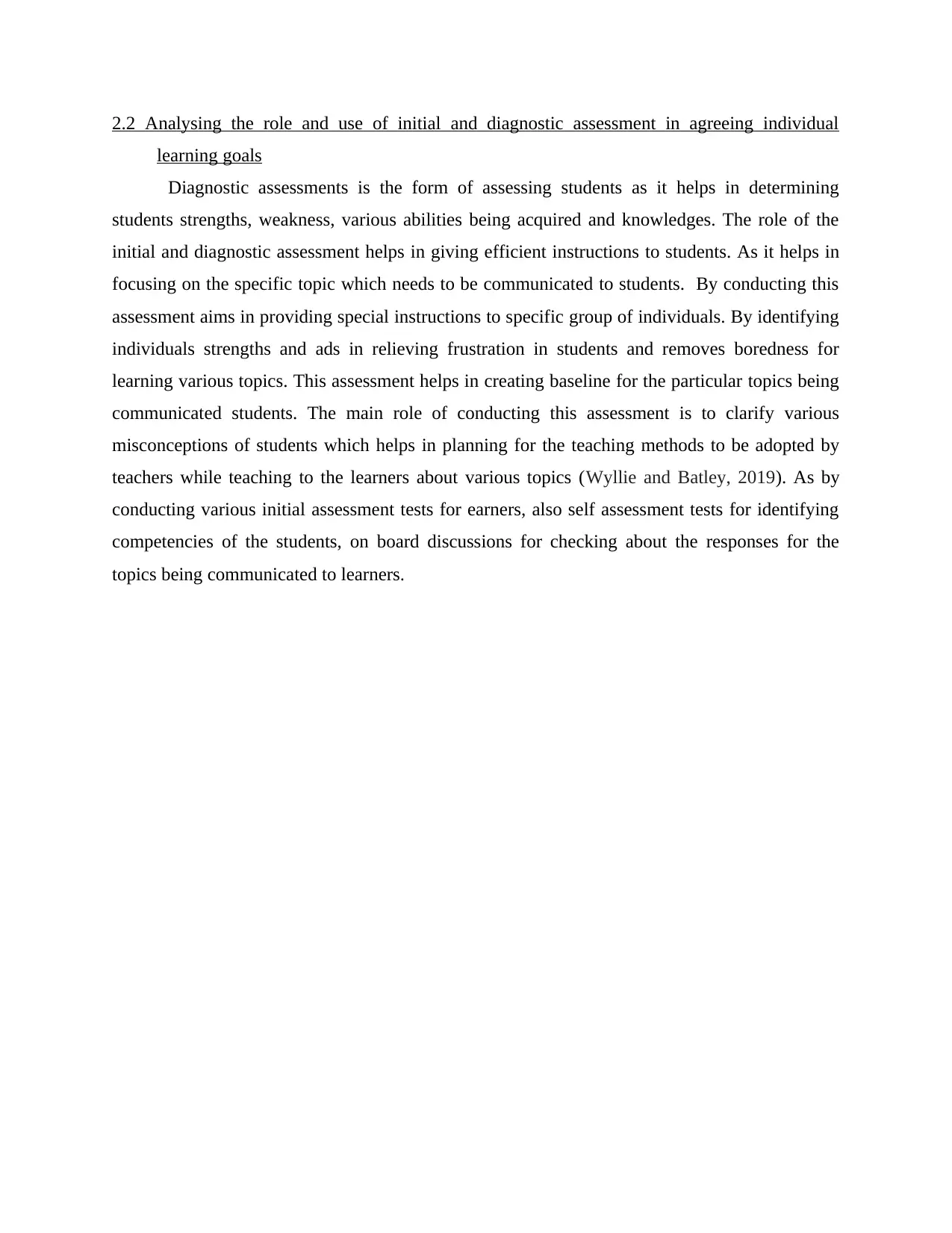
2.2 Analysing the role and use of initial and diagnostic assessment in agreeing individual
learning goals
Diagnostic assessments is the form of assessing students as it helps in determining
students strengths, weakness, various abilities being acquired and knowledges. The role of the
initial and diagnostic assessment helps in giving efficient instructions to students. As it helps in
focusing on the specific topic which needs to be communicated to students. By conducting this
assessment aims in providing special instructions to specific group of individuals. By identifying
individuals strengths and ads in relieving frustration in students and removes boredness for
learning various topics. This assessment helps in creating baseline for the particular topics being
communicated students. The main role of conducting this assessment is to clarify various
misconceptions of students which helps in planning for the teaching methods to be adopted by
teachers while teaching to the learners about various topics (Wyllie and Batley, 2019). As by
conducting various initial assessment tests for earners, also self assessment tests for identifying
competencies of the students, on board discussions for checking about the responses for the
topics being communicated to learners.
learning goals
Diagnostic assessments is the form of assessing students as it helps in determining
students strengths, weakness, various abilities being acquired and knowledges. The role of the
initial and diagnostic assessment helps in giving efficient instructions to students. As it helps in
focusing on the specific topic which needs to be communicated to students. By conducting this
assessment aims in providing special instructions to specific group of individuals. By identifying
individuals strengths and ads in relieving frustration in students and removes boredness for
learning various topics. This assessment helps in creating baseline for the particular topics being
communicated students. The main role of conducting this assessment is to clarify various
misconceptions of students which helps in planning for the teaching methods to be adopted by
teachers while teaching to the learners about various topics (Wyllie and Batley, 2019). As by
conducting various initial assessment tests for earners, also self assessment tests for identifying
competencies of the students, on board discussions for checking about the responses for the
topics being communicated to learners.
Paraphrase This Document
Need a fresh take? Get an instant paraphrase of this document with our AI Paraphraser
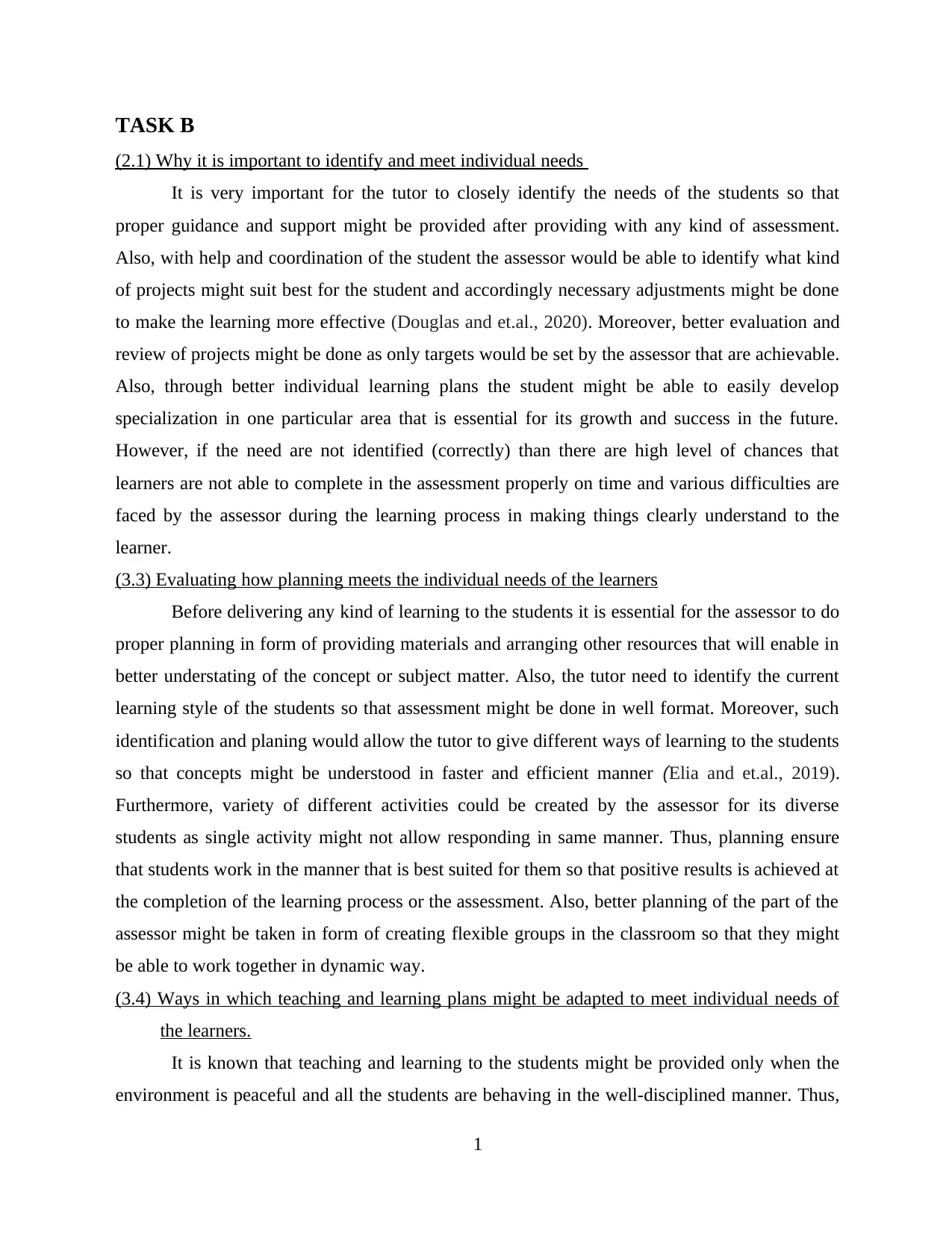
TASK B
(2.1) Why it is important to identify and meet individual needs
It is very important for the tutor to closely identify the needs of the students so that
proper guidance and support might be provided after providing with any kind of assessment.
Also, with help and coordination of the student the assessor would be able to identify what kind
of projects might suit best for the student and accordingly necessary adjustments might be done
to make the learning more effective (Douglas and et.al., 2020). Moreover, better evaluation and
review of projects might be done as only targets would be set by the assessor that are achievable.
Also, through better individual learning plans the student might be able to easily develop
specialization in one particular area that is essential for its growth and success in the future.
However, if the need are not identified (correctly) than there are high level of chances that
learners are not able to complete in the assessment properly on time and various difficulties are
faced by the assessor during the learning process in making things clearly understand to the
learner.
(3.3) Evaluating how planning meets the individual needs of the learners
Before delivering any kind of learning to the students it is essential for the assessor to do
proper planning in form of providing materials and arranging other resources that will enable in
better understating of the concept or subject matter. Also, the tutor need to identify the current
learning style of the students so that assessment might be done in well format. Moreover, such
identification and planing would allow the tutor to give different ways of learning to the students
so that concepts might be understood in faster and efficient manner (Elia and et.al., 2019).
Furthermore, variety of different activities could be created by the assessor for its diverse
students as single activity might not allow responding in same manner. Thus, planning ensure
that students work in the manner that is best suited for them so that positive results is achieved at
the completion of the learning process or the assessment. Also, better planning of the part of the
assessor might be taken in form of creating flexible groups in the classroom so that they might
be able to work together in dynamic way.
(3.4) Ways in which teaching and learning plans might be adapted to meet individual needs of
the learners.
It is known that teaching and learning to the students might be provided only when the
environment is peaceful and all the students are behaving in the well-disciplined manner. Thus,
1
(2.1) Why it is important to identify and meet individual needs
It is very important for the tutor to closely identify the needs of the students so that
proper guidance and support might be provided after providing with any kind of assessment.
Also, with help and coordination of the student the assessor would be able to identify what kind
of projects might suit best for the student and accordingly necessary adjustments might be done
to make the learning more effective (Douglas and et.al., 2020). Moreover, better evaluation and
review of projects might be done as only targets would be set by the assessor that are achievable.
Also, through better individual learning plans the student might be able to easily develop
specialization in one particular area that is essential for its growth and success in the future.
However, if the need are not identified (correctly) than there are high level of chances that
learners are not able to complete in the assessment properly on time and various difficulties are
faced by the assessor during the learning process in making things clearly understand to the
learner.
(3.3) Evaluating how planning meets the individual needs of the learners
Before delivering any kind of learning to the students it is essential for the assessor to do
proper planning in form of providing materials and arranging other resources that will enable in
better understating of the concept or subject matter. Also, the tutor need to identify the current
learning style of the students so that assessment might be done in well format. Moreover, such
identification and planing would allow the tutor to give different ways of learning to the students
so that concepts might be understood in faster and efficient manner (Elia and et.al., 2019).
Furthermore, variety of different activities could be created by the assessor for its diverse
students as single activity might not allow responding in same manner. Thus, planning ensure
that students work in the manner that is best suited for them so that positive results is achieved at
the completion of the learning process or the assessment. Also, better planning of the part of the
assessor might be taken in form of creating flexible groups in the classroom so that they might
be able to work together in dynamic way.
(3.4) Ways in which teaching and learning plans might be adapted to meet individual needs of
the learners.
It is known that teaching and learning to the students might be provided only when the
environment is peaceful and all the students are behaving in the well-disciplined manner. Thus,
1
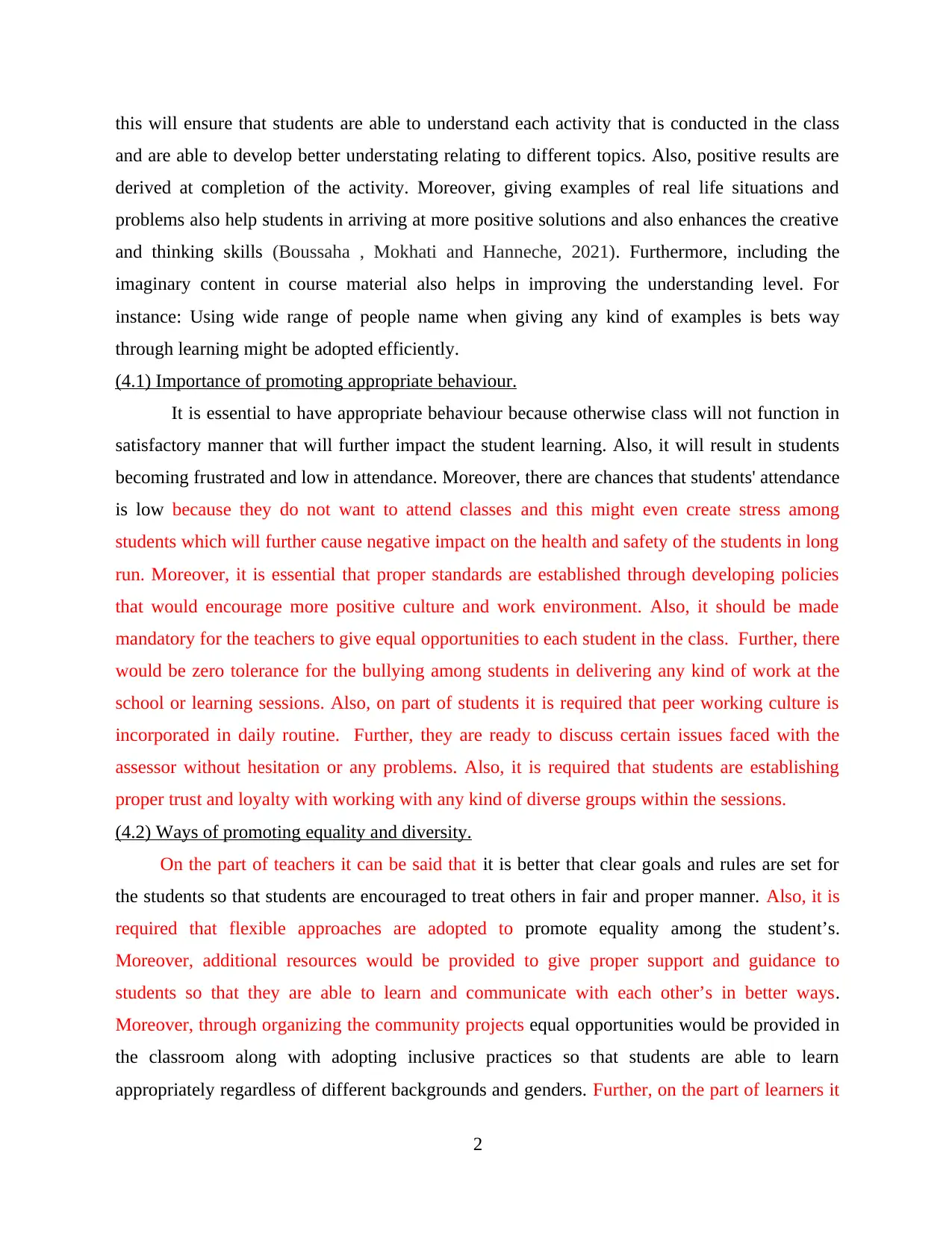
this will ensure that students are able to understand each activity that is conducted in the class
and are able to develop better understating relating to different topics. Also, positive results are
derived at completion of the activity. Moreover, giving examples of real life situations and
problems also help students in arriving at more positive solutions and also enhances the creative
and thinking skills (Boussaha , Mokhati and Hanneche, 2021). Furthermore, including the
imaginary content in course material also helps in improving the understanding level. For
instance: Using wide range of people name when giving any kind of examples is bets way
through learning might be adopted efficiently.
(4.1) Importance of promoting appropriate behaviour.
It is essential to have appropriate behaviour because otherwise class will not function in
satisfactory manner that will further impact the student learning. Also, it will result in students
becoming frustrated and low in attendance. Moreover, there are chances that students' attendance
is low because they do not want to attend classes and this might even create stress among
students which will further cause negative impact on the health and safety of the students in long
run. Moreover, it is essential that proper standards are established through developing policies
that would encourage more positive culture and work environment. Also, it should be made
mandatory for the teachers to give equal opportunities to each student in the class. Further, there
would be zero tolerance for the bullying among students in delivering any kind of work at the
school or learning sessions. Also, on part of students it is required that peer working culture is
incorporated in daily routine. Further, they are ready to discuss certain issues faced with the
assessor without hesitation or any problems. Also, it is required that students are establishing
proper trust and loyalty with working with any kind of diverse groups within the sessions.
(4.2) Ways of promoting equality and diversity.
On the part of teachers it can be said that it is better that clear goals and rules are set for
the students so that students are encouraged to treat others in fair and proper manner. Also, it is
required that flexible approaches are adopted to promote equality among the student’s.
Moreover, additional resources would be provided to give proper support and guidance to
students so that they are able to learn and communicate with each other’s in better ways.
Moreover, through organizing the community projects equal opportunities would be provided in
the classroom along with adopting inclusive practices so that students are able to learn
appropriately regardless of different backgrounds and genders. Further, on the part of learners it
2
and are able to develop better understating relating to different topics. Also, positive results are
derived at completion of the activity. Moreover, giving examples of real life situations and
problems also help students in arriving at more positive solutions and also enhances the creative
and thinking skills (Boussaha , Mokhati and Hanneche, 2021). Furthermore, including the
imaginary content in course material also helps in improving the understanding level. For
instance: Using wide range of people name when giving any kind of examples is bets way
through learning might be adopted efficiently.
(4.1) Importance of promoting appropriate behaviour.
It is essential to have appropriate behaviour because otherwise class will not function in
satisfactory manner that will further impact the student learning. Also, it will result in students
becoming frustrated and low in attendance. Moreover, there are chances that students' attendance
is low because they do not want to attend classes and this might even create stress among
students which will further cause negative impact on the health and safety of the students in long
run. Moreover, it is essential that proper standards are established through developing policies
that would encourage more positive culture and work environment. Also, it should be made
mandatory for the teachers to give equal opportunities to each student in the class. Further, there
would be zero tolerance for the bullying among students in delivering any kind of work at the
school or learning sessions. Also, on part of students it is required that peer working culture is
incorporated in daily routine. Further, they are ready to discuss certain issues faced with the
assessor without hesitation or any problems. Also, it is required that students are establishing
proper trust and loyalty with working with any kind of diverse groups within the sessions.
(4.2) Ways of promoting equality and diversity.
On the part of teachers it can be said that it is better that clear goals and rules are set for
the students so that students are encouraged to treat others in fair and proper manner. Also, it is
required that flexible approaches are adopted to promote equality among the student’s.
Moreover, additional resources would be provided to give proper support and guidance to
students so that they are able to learn and communicate with each other’s in better ways.
Moreover, through organizing the community projects equal opportunities would be provided in
the classroom along with adopting inclusive practices so that students are able to learn
appropriately regardless of different backgrounds and genders. Further, on the part of learners it
2
⊘ This is a preview!⊘
Do you want full access?
Subscribe today to unlock all pages.

Trusted by 1+ million students worldwide
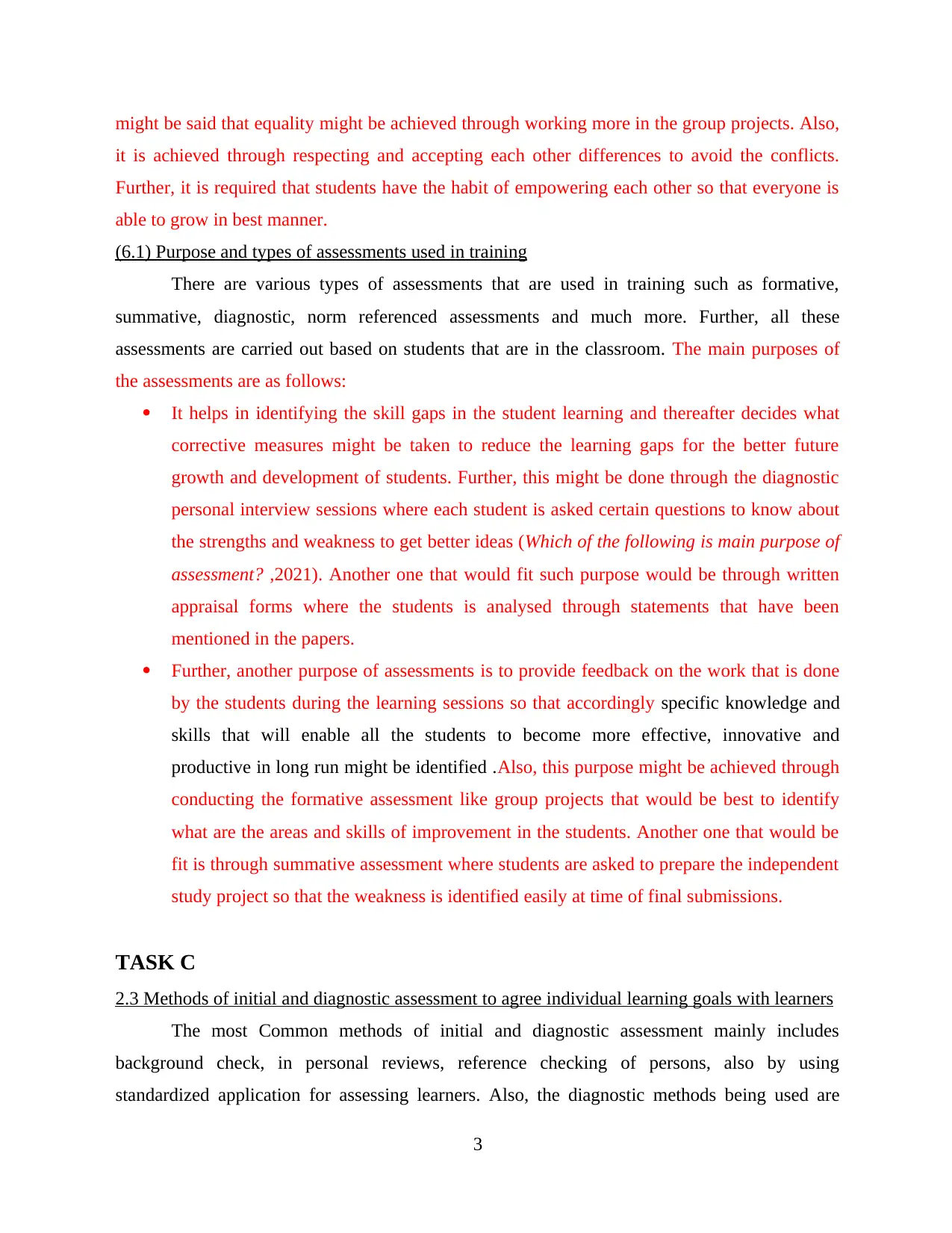
might be said that equality might be achieved through working more in the group projects. Also,
it is achieved through respecting and accepting each other differences to avoid the conflicts.
Further, it is required that students have the habit of empowering each other so that everyone is
able to grow in best manner.
(6.1) Purpose and types of assessments used in training
There are various types of assessments that are used in training such as formative,
summative, diagnostic, norm referenced assessments and much more. Further, all these
assessments are carried out based on students that are in the classroom. The main purposes of
the assessments are as follows:
It helps in identifying the skill gaps in the student learning and thereafter decides what
corrective measures might be taken to reduce the learning gaps for the better future
growth and development of students. Further, this might be done through the diagnostic
personal interview sessions where each student is asked certain questions to know about
the strengths and weakness to get better ideas (Which of the following is main purpose of
assessment? ,2021). Another one that would fit such purpose would be through written
appraisal forms where the students is analysed through statements that have been
mentioned in the papers.
Further, another purpose of assessments is to provide feedback on the work that is done
by the students during the learning sessions so that accordingly specific knowledge and
skills that will enable all the students to become more effective, innovative and
productive in long run might be identified .Also, this purpose might be achieved through
conducting the formative assessment like group projects that would be best to identify
what are the areas and skills of improvement in the students. Another one that would be
fit is through summative assessment where students are asked to prepare the independent
study project so that the weakness is identified easily at time of final submissions.
TASK C
2.3 Methods of initial and diagnostic assessment to agree individual learning goals with learners
The most Common methods of initial and diagnostic assessment mainly includes
background check, in personal reviews, reference checking of persons, also by using
standardized application for assessing learners. Also, the diagnostic methods being used are
3
it is achieved through respecting and accepting each other differences to avoid the conflicts.
Further, it is required that students have the habit of empowering each other so that everyone is
able to grow in best manner.
(6.1) Purpose and types of assessments used in training
There are various types of assessments that are used in training such as formative,
summative, diagnostic, norm referenced assessments and much more. Further, all these
assessments are carried out based on students that are in the classroom. The main purposes of
the assessments are as follows:
It helps in identifying the skill gaps in the student learning and thereafter decides what
corrective measures might be taken to reduce the learning gaps for the better future
growth and development of students. Further, this might be done through the diagnostic
personal interview sessions where each student is asked certain questions to know about
the strengths and weakness to get better ideas (Which of the following is main purpose of
assessment? ,2021). Another one that would fit such purpose would be through written
appraisal forms where the students is analysed through statements that have been
mentioned in the papers.
Further, another purpose of assessments is to provide feedback on the work that is done
by the students during the learning sessions so that accordingly specific knowledge and
skills that will enable all the students to become more effective, innovative and
productive in long run might be identified .Also, this purpose might be achieved through
conducting the formative assessment like group projects that would be best to identify
what are the areas and skills of improvement in the students. Another one that would be
fit is through summative assessment where students are asked to prepare the independent
study project so that the weakness is identified easily at time of final submissions.
TASK C
2.3 Methods of initial and diagnostic assessment to agree individual learning goals with learners
The most Common methods of initial and diagnostic assessment mainly includes
background check, in personal reviews, reference checking of persons, also by using
standardized application for assessing learners. Also, the diagnostic methods being used are
3
Paraphrase This Document
Need a fresh take? Get an instant paraphrase of this document with our AI Paraphraser
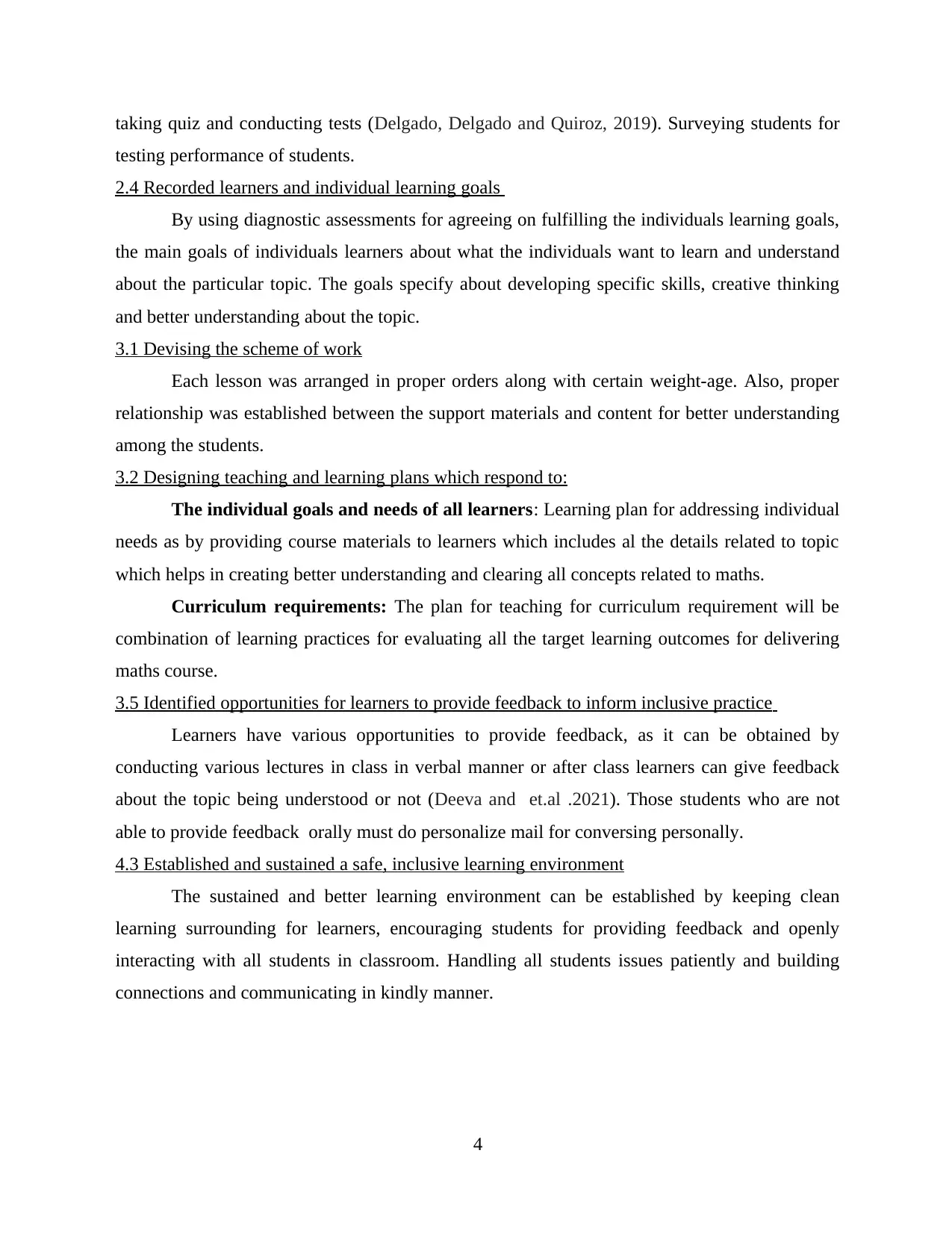
taking quiz and conducting tests (Delgado, Delgado and Quiroz, 2019). Surveying students for
testing performance of students.
2.4 Recorded learners and individual learning goals
By using diagnostic assessments for agreeing on fulfilling the individuals learning goals,
the main goals of individuals learners about what the individuals want to learn and understand
about the particular topic. The goals specify about developing specific skills, creative thinking
and better understanding about the topic.
3.1 Devising the scheme of work
Each lesson was arranged in proper orders along with certain weight-age. Also, proper
relationship was established between the support materials and content for better understanding
among the students.
3.2 Designing teaching and learning plans which respond to:
The individual goals and needs of all learners: Learning plan for addressing individual
needs as by providing course materials to learners which includes al the details related to topic
which helps in creating better understanding and clearing all concepts related to maths.
Curriculum requirements: The plan for teaching for curriculum requirement will be
combination of learning practices for evaluating all the target learning outcomes for delivering
maths course.
3.5 Identified opportunities for learners to provide feedback to inform inclusive practice
Learners have various opportunities to provide feedback, as it can be obtained by
conducting various lectures in class in verbal manner or after class learners can give feedback
about the topic being understood or not (Deeva and et.al .2021). Those students who are not
able to provide feedback orally must do personalize mail for conversing personally.
4.3 Established and sustained a safe, inclusive learning environment
The sustained and better learning environment can be established by keeping clean
learning surrounding for learners, encouraging students for providing feedback and openly
interacting with all students in classroom. Handling all students issues patiently and building
connections and communicating in kindly manner.
4
testing performance of students.
2.4 Recorded learners and individual learning goals
By using diagnostic assessments for agreeing on fulfilling the individuals learning goals,
the main goals of individuals learners about what the individuals want to learn and understand
about the particular topic. The goals specify about developing specific skills, creative thinking
and better understanding about the topic.
3.1 Devising the scheme of work
Each lesson was arranged in proper orders along with certain weight-age. Also, proper
relationship was established between the support materials and content for better understanding
among the students.
3.2 Designing teaching and learning plans which respond to:
The individual goals and needs of all learners: Learning plan for addressing individual
needs as by providing course materials to learners which includes al the details related to topic
which helps in creating better understanding and clearing all concepts related to maths.
Curriculum requirements: The plan for teaching for curriculum requirement will be
combination of learning practices for evaluating all the target learning outcomes for delivering
maths course.
3.5 Identified opportunities for learners to provide feedback to inform inclusive practice
Learners have various opportunities to provide feedback, as it can be obtained by
conducting various lectures in class in verbal manner or after class learners can give feedback
about the topic being understood or not (Deeva and et.al .2021). Those students who are not
able to provide feedback orally must do personalize mail for conversing personally.
4.3 Established and sustained a safe, inclusive learning environment
The sustained and better learning environment can be established by keeping clean
learning surrounding for learners, encouraging students for providing feedback and openly
interacting with all students in classroom. Handling all students issues patiently and building
connections and communicating in kindly manner.
4
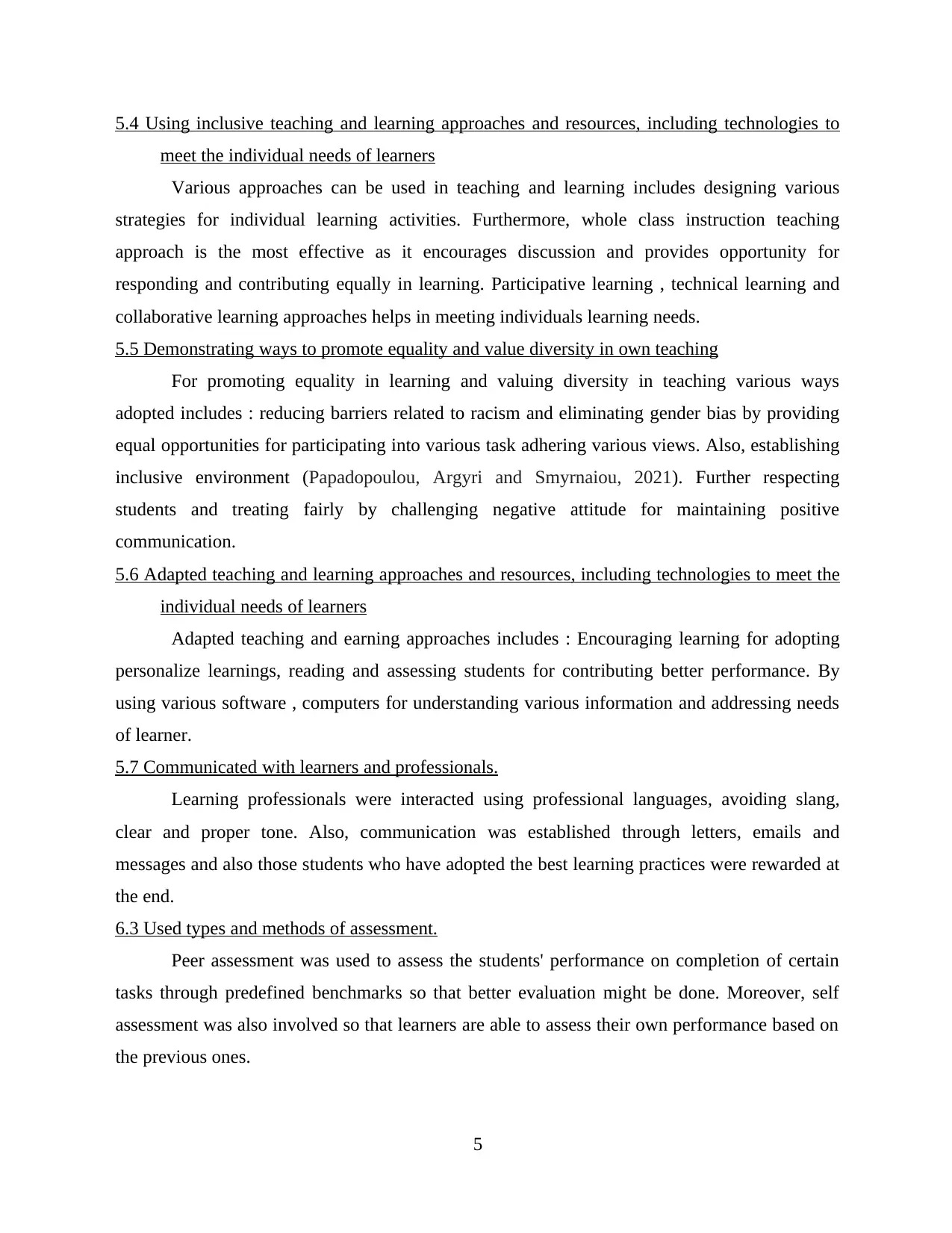
5.4 Using inclusive teaching and learning approaches and resources, including technologies to
meet the individual needs of learners
Various approaches can be used in teaching and learning includes designing various
strategies for individual learning activities. Furthermore, whole class instruction teaching
approach is the most effective as it encourages discussion and provides opportunity for
responding and contributing equally in learning. Participative learning , technical learning and
collaborative learning approaches helps in meeting individuals learning needs.
5.5 Demonstrating ways to promote equality and value diversity in own teaching
For promoting equality in learning and valuing diversity in teaching various ways
adopted includes : reducing barriers related to racism and eliminating gender bias by providing
equal opportunities for participating into various task adhering various views. Also, establishing
inclusive environment (Papadopoulou, Argyri and Smyrnaiou, 2021). Further respecting
students and treating fairly by challenging negative attitude for maintaining positive
communication.
5.6 Adapted teaching and learning approaches and resources, including technologies to meet the
individual needs of learners
Adapted teaching and earning approaches includes : Encouraging learning for adopting
personalize learnings, reading and assessing students for contributing better performance. By
using various software , computers for understanding various information and addressing needs
of learner.
5.7 Communicated with learners and professionals.
Learning professionals were interacted using professional languages, avoiding slang,
clear and proper tone. Also, communication was established through letters, emails and
messages and also those students who have adopted the best learning practices were rewarded at
the end.
6.3 Used types and methods of assessment.
Peer assessment was used to assess the students' performance on completion of certain
tasks through predefined benchmarks so that better evaluation might be done. Moreover, self
assessment was also involved so that learners are able to assess their own performance based on
the previous ones.
5
meet the individual needs of learners
Various approaches can be used in teaching and learning includes designing various
strategies for individual learning activities. Furthermore, whole class instruction teaching
approach is the most effective as it encourages discussion and provides opportunity for
responding and contributing equally in learning. Participative learning , technical learning and
collaborative learning approaches helps in meeting individuals learning needs.
5.5 Demonstrating ways to promote equality and value diversity in own teaching
For promoting equality in learning and valuing diversity in teaching various ways
adopted includes : reducing barriers related to racism and eliminating gender bias by providing
equal opportunities for participating into various task adhering various views. Also, establishing
inclusive environment (Papadopoulou, Argyri and Smyrnaiou, 2021). Further respecting
students and treating fairly by challenging negative attitude for maintaining positive
communication.
5.6 Adapted teaching and learning approaches and resources, including technologies to meet the
individual needs of learners
Adapted teaching and earning approaches includes : Encouraging learning for adopting
personalize learnings, reading and assessing students for contributing better performance. By
using various software , computers for understanding various information and addressing needs
of learner.
5.7 Communicated with learners and professionals.
Learning professionals were interacted using professional languages, avoiding slang,
clear and proper tone. Also, communication was established through letters, emails and
messages and also those students who have adopted the best learning practices were rewarded at
the end.
6.3 Used types and methods of assessment.
Peer assessment was used to assess the students' performance on completion of certain
tasks through predefined benchmarks so that better evaluation might be done. Moreover, self
assessment was also involved so that learners are able to assess their own performance based on
the previous ones.
5
⊘ This is a preview!⊘
Do you want full access?
Subscribe today to unlock all pages.

Trusted by 1+ million students worldwide
1 out of 17
Related Documents
Your All-in-One AI-Powered Toolkit for Academic Success.
+13062052269
info@desklib.com
Available 24*7 on WhatsApp / Email
![[object Object]](/_next/static/media/star-bottom.7253800d.svg)
Unlock your academic potential
Copyright © 2020–2025 A2Z Services. All Rights Reserved. Developed and managed by ZUCOL.